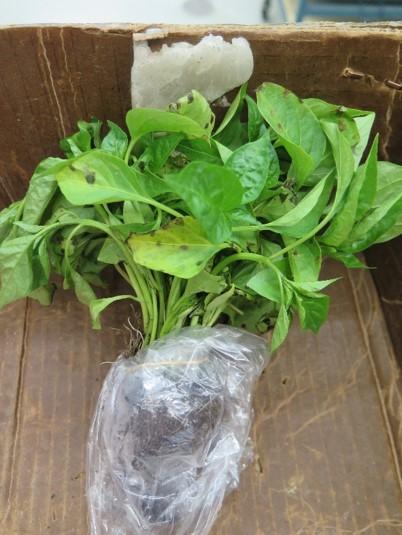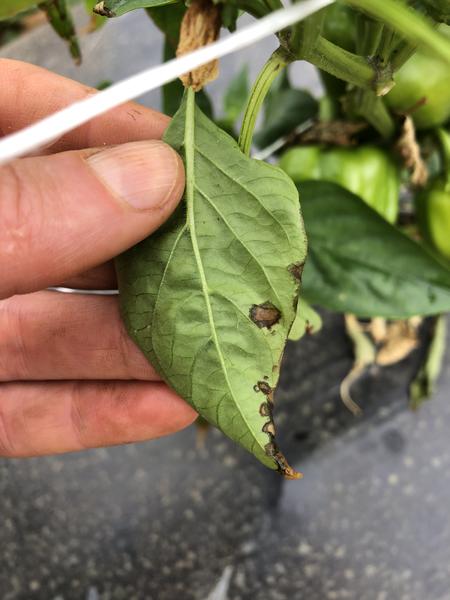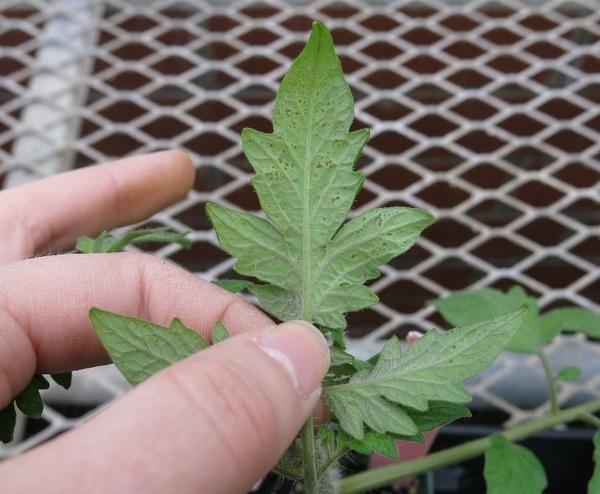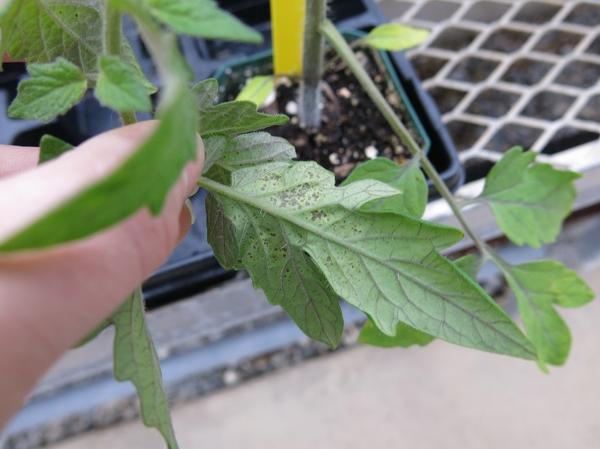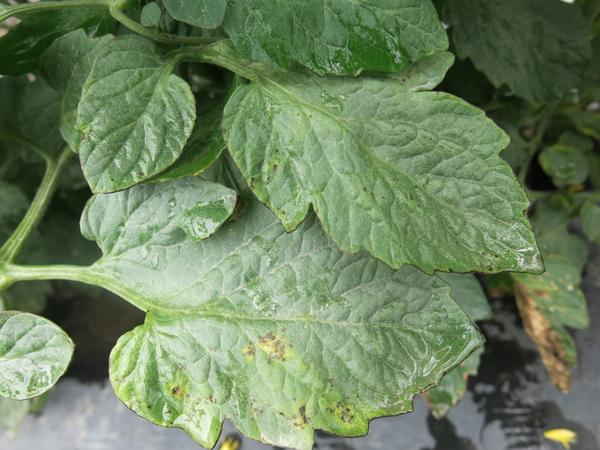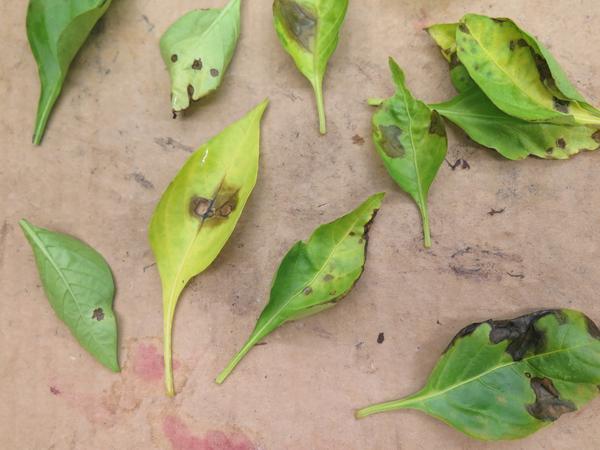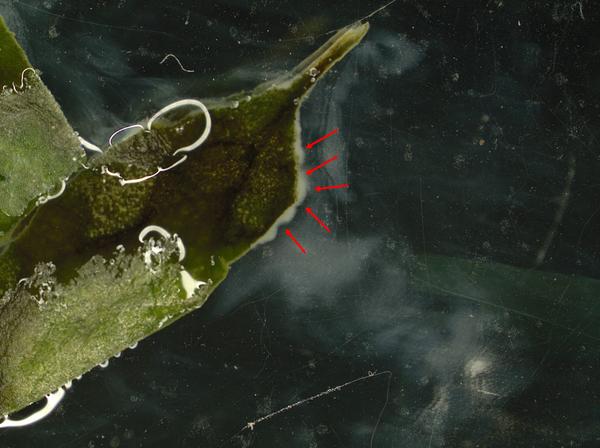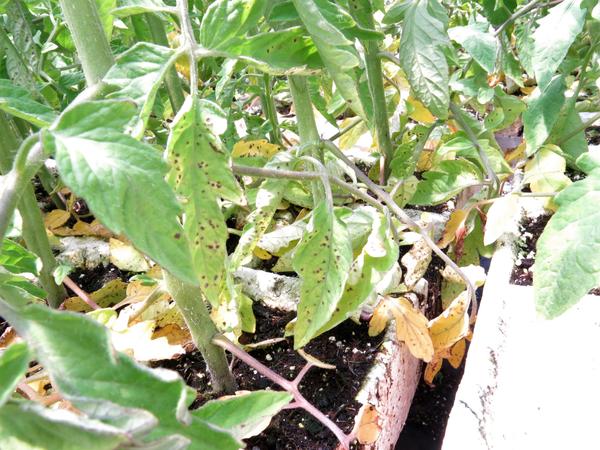General Information
Bacterial spot is caused by four species of Xanthomonas and occurs worldwide wherever tomatoes or peppers are grown. Bacterial spot causes leaf and fruit spots, which leads to defoliation, sun-scalded fruit, and yield loss. Due to diversity within the bacterial spot pathogens, the disease can occur at different temperatures and is a threat to tomato production worldwide. Disease development is favored by temperatures of 75 to 86 ℉ and high precipitation. In North Carolina, it is more prevalent in seasons with high precipitation and less prevalent during dry years.
Pathogen
The disease is caused by four species of Xanthomonas (X. euvesicatoria, X. gardneri, X. perforans, and X. vesicatoria). In North Carolina, X. perforans is the predominant species associated with bacterial spot on tomato and X. euvesicatoria is the predominant species associated with the disease on pepper. All four bacteria are strictly aerobic, gram-negative rods with a long whip-like flagellum (tail) that allows them to move in water, which allows them to invade wet plant tissue and cause infection.
Symptoms and Signs
On tomato, leaf lesions are initially circular and water-soaked and may be surrounded by a faint yellow halo. In general, spots are dark brown to black and circular on leaves and stems. Spots rarely develop to more than 3 mm in diameter. Lesions can coalesce causing a blighted appearance of leaves and a general yellowing may occur on leaves with multiple lesions. Infected pepper leaves drop prematurely; this exposes fruit to the sun and results in sun scalding. Fruit lesions begin as small, slightly raised blisters, which become dark brown, scab-like, and can appear slightly raised as they increase in size.
On leaflets, bacterial spot can be easily confused with the early symptoms of bacterial speck, early blight, gray leaf spot, target spot, or Septoria leaf spot. When Xanthomonas is present, bacteria will ooze (also referred to as bacterial streaming) from infected tissue and can be observed under a light microscope. Bacterial streaming will not be observed in lesions caused by fungal pathogens.
View this brief video to help you identify bacterial spot of tomato!
Disease Cycle and Epidemiology
Infected plant tissue such as seeds, transplants, tomato and pepper volunteers, and crop debris are all potential sources of bacterial spot inoculum. In North Carolina, most disease outbreaks can be traced to contaminated seeds or diseased transplants. Disease development is favored by temperatures of 75 to 86℉, and high precipitation and humidity. The pathogens can invade the plant through natural openings (e.g. stomata and hydathodes) and wounds.
Bacteria can move within fields by wind-driven rain, irrigation droplets, aerosols, and the handling of wet plants. The longer the plants are wet, infection is more likely to occur. After initial infection, the disease can spread rapidly throughout an entire field or greenhouse. The bacterial spot pathogens can be recovered from non-symptomatic plants as early as one week at distances of up to 4 m from symptomatic plants. In the greenhouse, the disease can spread up to 2 m to neighboring plants from symptomatic plants within three weeks due to overhead irrigation.
General Disease Management
Management of the disease focuses on preventive control measures throughout the season. Once a field becomes infested, bacterial spot is difficult to control, especially under conducive disease conditions. Therefore, preventative control measures are very important. Losses can be reduced by adopting the following management strategies:
- The most effective management strategy is the use of pathogen-free certified seeds and disease-free transplants to prevent the introduction of the pathogen into greenhouses and field production areas. Inspect plants very carefully and reject infected transplants- including your own!
- In the greenhouse, discard trays adjacent to outbreak location to minimize disease spread.
- Treat seeds with dilute bleach, hydrochloric acid, or hot water to reduce the potential for seedling infection. However, this seed treatment is not recommended for producers that use pelleted seeds as it will remove the pelleted coating from seeds. These treatments may also reduce seed germination. Perform a test treatment on approximately 50 to 100 seeds and check for the effect on germination before treating an entire seed lot. For specific instructions and recommendations please consult the Southeastern US Vegetable Crop Handbook.
- In transplant production greenhouses, minimize overwatering and handling of seedlings when they are wet.
- Trays, benches, tools, and greenhouse structures should be washed and sanitized between seedlings crops.
- Crop rotation to a non-solanaceous crop should be used to avoid pathogen carryover on volunteers and crop residue. Avoid fields that have been planted with peppers or tomatoes within one year, especially if they had bacterial spot previously.
- Eliminate solanaceous weeds in and around tomato and pepper production areas.
- Keep cull piles away from field operations.
- Do not spray, tie, harvest, or handle wet plants as that can spread the disease.
Disease Control for Conventional Growers
Several fungicides are labeled for use on tomato and pepper to manage bacterial spot (Table 1). All products provide the best control if applied preventatively; there are no curative products for bacterial spot management. For the latest fungicide recommendations for southern blight of tomato and pepper, see the Southeastern US Vegetable Crop Handbook. Fungicide labels are legal documents—always read and follow fungicide labels.
| Active Ingredient | Product | PHI (day) | Group1 | Crop(s) | Production Area |
|---|---|---|---|---|---|
|
Copper-based compounds2 |
Various |
N/A |
M1 |
Pepper Tomato |
Greenhouse Field |
|
Mancozeb + copper hydroxide |
ManKocide |
5 |
M3 + M1 |
Pepper Tomato |
Greenhouse Field |
|
Streptomycin sulfate |
Agri-mycin 17 Harbour |
N/A |
25 |
Pepper Tomato |
Greenhouse |
|
Bacteriophage3 |
AgriPhage |
N/A |
N/A |
Pepper Tomato |
Greenhouse Field |
|
Acibenzolar-S-methyl |
Actigard 50WG |
14 |
P |
Pepper Tomato |
Greenhouse use not prohibited Field |
|
1 FRAC code (fungicide group). |
|||||
Disease Management for Organic Growers
Organic growers should follow the general disease management recommendations above in addition to the products listed below to obtain adequate control of bacterial spot. All products listed are OMRI-approved at the time of this publication. Always check the label for current restrictions.
| Active Ingredient | Product Name | PHI | Group1 | Crop(s) | Production Area |
|---|---|---|---|---|---|
|
Bacillus amyloliquefasciens strain MBI 600 |
Serifel |
0 |
44 |
Pepper Tomato |
Field |
|
Bacillus subtilis strain QST 713 |
Serenade ASO Serenade Opti |
0 |
44 |
Pepper Tomato |
Greenhouse Field |
|
Bacillus mycoides isolate J |
LifeGard WG |
0 |
44 |
Pepper Tomato |
Greenhouse Field |
| copper (various formulations) | (various) | (see label) | M01 | (see label) | (see label) |
|
Methyl salicylate + Bacillus thuringiensis sups. kurstaki |
Leap ES |
Not Listed |
44 |
Pepper Tomato |
Greenhouse Field |
| 1FRAC group (fungicide group) | |||||
Disease Management for Home Owners
Home owners should use the general disease management recommendations listed above. Some of the products listed above may be available for home owners to use.
Resources
- The NC State Plant Disease and Insect Clinic provides diagnostics and control recommendations
- The NC State Extension Plant Pathology Portal provides information on crop disease management
- The Southeastern US Vegetable Crop Handbook provides information on vegetable disease management
Acknowledgments
This disease factsheet was prepared by the Meadows Plant Pathology Lab.
Funding for updating this factsheet comes from the United States Department of Agriculture (USDA)-National Instiute of Food and Agriculture (NIFA) (2017-70006-27141).
Publication date: Feb. 14, 2019
N.C. Cooperative Extension prohibits discrimination and harassment regardless of age, color, disability, family and marital status, gender identity, national origin, political beliefs, race, religion, sex (including pregnancy), sexual orientation and veteran status.
Recommendations for the use of agricultural chemicals are included in this publication as a convenience to the reader. The use of brand names and any mention or listing of commercial products or services in this publication does not imply endorsement by NC State University or N.C. A&T State University nor discrimination against similar products or services not mentioned. Individuals who use agricultural chemicals are responsible for ensuring that the intended use complies with current regulations and conforms to the product label. Be sure to obtain current information about usage regulations and examine a current product label before applying any chemical. For assistance, contact your local N.C. Cooperative Extension county center.
N.C. Cooperative Extension prohibits discrimination and harassment regardless of age, color, disability, family and marital status, gender identity, national origin, political beliefs, race, religion, sex (including pregnancy), sexual orientation and veteran status.


